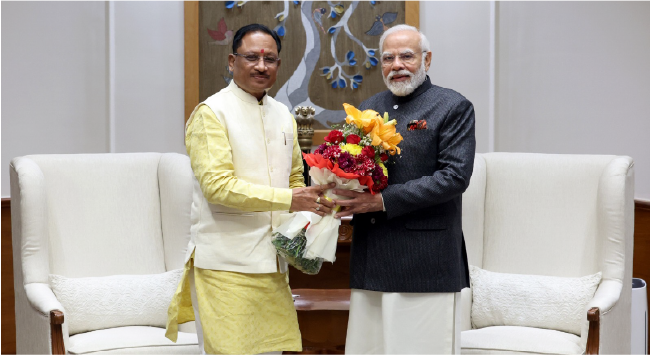Summary
The surprise choice of chief ministers in the three states of Chhattisgarh, Madhya Pradesh and Rajasthan reaffirmed the primacy of the Bharatiya Janata Party high command in state politics.
The chief ministerial appointments in the three states of Chhattisgarh, Madhya Pradesh and Rajasthan – where the Bharatiya Janata Party (BJP) won convincingly in the recently-held elections – came as a surprise to most. As in some earlier instances, the eventual appointments, made by the party high command, were not the ones that were being talked about the most during the elections.
Perhaps the most unexpected of the appointments was in Rajasthan where first-time member of the legislative assembly (MLA) Bhajan Lal Sharma was sworn in as chief minister. Sharma, a Brahmin by caste, was elected for the first time to the state assembly from the Sanganer constituency in the Jaipur area, considered a BJP stronghold. Although a first-time MLA – he, in fact, lost in 2003, the only time that he contested the assembly elections earlier on a Rajasthan Samajik Nyaya Manch ticket – Sharma has been involved in the BJP organisation in Rajasthan for over three decades. He began his political career in student politics being associated with the Bharatiya Janata Yuva Morcha from the 1990s. He was later elected as a sarpanch (village head) and went on to become the BJP’s Bharatpur district unit president and the party general secretary in charge of the BJP headquarters in Jaipur.
The selection of Sharma as chief minister meant that several senior contenders from Rajasthan, including former state chief minister, Vasundhara Raje, were bypassed. There were others like central ministers Gajendra Singh Shekhawat, Arjun Ram Meghwal and Ashwini Vaishnaw whose names were doing the rounds. Although it was Raje who announced Sharma’s name at the legislature party meeting in the presence of the BJP’s central observers, there is a definite sense that Raje has been sidelined. The 70-year-old Raje, who won from Jhalrapatan, is a two-term chief minister and has, over the years, had run-ins with the party high command. As in the other two states, and what has now become a trend in the larger BJP-ruled states, there were two deputy chief ministers appointed: Diya Sharma, a Thakur with a royal lineage, and Prem Chand Bairwa, a Dalit or Scheduled Caste.
In Madhya Pradesh, the BJP sprung a surprise too with the appointment of Mohan Yadav, an Other Backward Classes (OBC) leader and three-time MLA, as the state’s chief minister. Following the election results, where the BJP swept the polls, the names that were being discussed were four-time Madhya Pradesh chief minister, Shivraj Singh Chouhan, former Union ministers Prahlad Patel and Narendra Tomar, party heavyweight Kailash Vijayvargiya, the state unit chief V D Sharma and Union minister and former Congressman Jyotiraditya Scindia. Jagdish Devda and Rajendra Shukla were appointed as the deputy chief ministers of Madhya Pradesh and Tomar the Speaker of the state assembly. Some of the other senior leaders, such as Patel and Vijayvargiya, have found place in the state cabinet.
In the normal course of events Chouhan, who is relatively young by the standards of Indian politics at 64 years and had played a pivotal role during the election campaign, should have been the frontrunner. However, he was not being projected for the chief minister’s post even during the campaign. Being a loyal party member, Chouhan did not express any open dissatisfaction after Yadav’s appointment, but some of his statements after being overlooked hinted at a sense of anguish.
In Chhattisgarh, Vishnu Deo Sai, an Adivasi or tribal leader, was appointed chief minister. The choice of Sai was the least surprising of the three states since Adivasis constitute a third of Chhattisgarh’s population and had backed the BJP in the elections. Sai is a four-term member of parliament, who has been the president of the Chhattisgarh party unit from 2020 to 2022, and is known for his organisational acumen. As in Madhya Pradesh and Rajasthan, two deputy chief ministers, Vijay Sharma and Arun Sao, were appointed. Raman Singh, who had served as state chief minister for three terms, was never in the running for the chief minister’s post and has been appointed Speaker of the Chhattisgarh assembly.
The recent chief ministerial appointment, coming in the run up to the general elections, reaffirmed some of the strategies employed by the BJP under Prime Minister Narendra Modi. First, the party high command’s chief ministerial appointments were meant to ensure that tall state leaders are not allowed to grow beyond a limit. This has certain similarities with the Congress under Indira Gandhi where regional satraps were sought to be cut to size. Second, the BJP has preferred relatively young leaders as chief ministers even as attention turns to the general elections. Finally, although Modi has said in a recent speech that he recognises only four ‘castes’ – women, farmers, youth and the poor – the BJP has carefully balanced traditional caste interests in its appointment of chief ministers and their deputies. This will stand the BJP in good stead in the 2024 general elections where it will look to retain its social coalition of upper castes, OBCs, Dalits and Adivasis in the Hindi belt.
. . . . .
Dr Ronojoy Sen is Senior Research Fellow and Research Lead (Politics, Society and Governance) at the Institute of South Asian Studies (ISAS), an autonomous research institute at the National University of Singapore (NUS). He can be contacted at isasrs@nus.edu.sg. The author bears full responsibility for the facts cited and opinions expressed in this paper.
Pic Credit: Vishnu Deo Sai (@vishnudsai) / X (twitter.com)
-
 More From :
More From :
-
 Tags :
Tags :
-
 Download PDF
Download PDF



